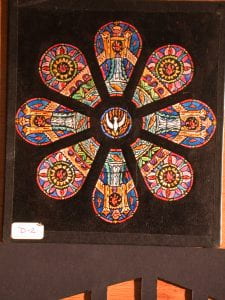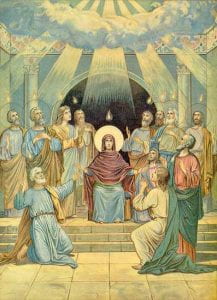Typically people assume objects that carry deep meanings are elaborate and grand, however in some cases the objects that lack such details carry an even stronger message. Pictured above is a wood carving of the Holy Spirit represented as a Dove. It is about six inches tall, three inches wide and is made out of a dark, glossy wood. The carving can be hung on a wall or stood upright using pegs, allowing it to be displayed in a variety of places. When displayed, the Dove is shown facing downward to represent the belief of the descension of the Holy Spirit unto those who are in need. This particular carving was given to one of our group members as a gift from his grandparents for his Catholic Confirmation in 2011. As this object was gifted to him for a special religious occasion, it now embodies a powerful message of religion and memory.
In the Catholic faith, members believe that God is divided into three equal parts: the Father, the Son, and the Holy Spirit. The Holy Spirit is essentially the spirit of God and the power of it is mentioned all throughout stories in the Bible. For example, the prophet Micah was able to follow on the right path with the help of the Holy Spirit. “The earth was without form and void, and darkness was over the face of the deep. And the Spirit of God was hovering over the face of the waters” (Ezigbo, 190). This is the first time we encounter God’s Spirit in the Bible. The Holy Spirit embodies the power of God and its purpose is to guide God’s people to eternal life in heaven.
The Holy Spirit is represented in multiple ways throughout the Bible, however the most recognizable is that of the Dove. The Dove was first used as a representation of the Holy Spirit during the Baptism of Christ, where all four Gospels said that “the Holy Spirit descended on Christ in the form of a Dove” (Walvoord, 20). The Dove is used because of four qualities that are tied to the idea of the Holy Spirit and to the bird itself. The first of these four qualities is beauty, followed by gentleness, peace, and a heavenly nature and origin, all of which are represented by the symbol of the Dove. Pieces of art, such as stained glass windows, use the Dove in the same way that this wood carving does. This wood carving uses lines to show the Heavenly nature of the Dove, where the stained glass windows use color to show this property.

This is an image of a stained glass window in Charlotte, North Carolina that shows another depiction of the Holy Spirit as a Dove.
As the Holy Spirit takes on an intangible form, Catholics look to material objects to help understand its power and importance. By taking the Holy Spirit and representing it in a physical form, it allows people to build a deeper understanding of it. The object’s lack of color and flare gives it an ambiguous aspect that allows it to be displayed in secular spaces. The Holy Spirit can be represented in many different ways in addition to a Dove. This gives it a form of camouflage that allows it to hide in plain sight. This is significant as someone can take an object, like a wood carving, that has a different representation of the Holy Spirit and display it in a location where religion is not present.
The Holy Spirit is a central theme of gifts for those completing Confirmation. Like other sects of Christianity, Confirmation is the final of the three major sacraments that are required for the full initiation into Catholicism. The Holy Spirit is chosen as a symbol for Confirmation because during the process, young Christians are receiving the 7 Gifts of the Holy Spirit. The 7 Gifts are: wisdom, understanding, right judgment, courage, knowledge, reverence, and awe and wonder. At the first Pentecost over 2000 years ago, the Holy Spirit came to bless the Apostles of Jesus Christ with these 7 gifts and “has been guiding the church ever since,” (Keating). According to Father Daniel McBride, a pastor in the Diocese of Phoenix, “prior to the Apostles receiving the Holy Spirit at Pentecost, they are timid and confused. And yet as soon as they receive, they are bold, great preachers that are ready to face the world” (Keating). All Christians, past and present, are connected by the blessings of the Holy Spirit in this way. Holy Spirit themed objects allow those who are newly Confirmed to have a reminder that they are blessed with these gifts and that they will be with them for the rest of their lives.
In American culture, the act of giving gifts is very prominent with holidays and milestone events in the lives of children. Objects, like this one can be found in both religious and secular bookstores throughout America. This makes them easily accessible to those looking to give a gift to someone that symbolizes an important event, such as Conformation. As Jesus was given the gift of the Holy Spirit at his baptism, Catholics believe that members receive that same gift at baptisms of their own. The act of giving a gift for religious occasions ties their religion to that event since the “visual, sensual, and tactile of [an] object offers an immediacy that ideas do not always have” (McDannell, 223). The activation of an object through gift giving assigns it the religious meaning that it carries. In her book Material Christianity, McDannell mentions that “Churchgoing goes far beyond an hour on Sunday Morning,” which can be seen in the act of gift giving (McDannell, 223). Our own object demonstrates this activation since it was gifted to a group member for his Confirmation, and serves as a reminder of the memories that accompany it.
By Sienna Bargiel, Denny Fuller, and Corey Knight
Special thanks to Steve Aderton for assisting us in using the Carvey to create a 3D model of our object.
Bibliography
“Catholic Faith Series: The Holy Spirit.” A Nun’s Life Ministry. Accessed April 10, 2018. https://anunslife.org/resources/catholic-faith-series-the-holy-spirit.
Ezigbo, Victor I. “Holy Spirit.” In Introducing Christian Theologies, Volume 1: Voices from Global Christian Communities, Vol. 1,189-217. Cambridge: Lutterworth Press, 2013. http://www.jstor.org/stable/j.ctt1ffjnm7.12.
J. & R. Lamb Studios. Design drawing for stained glass window with floral/round composition with Holy Spirit at center, fish, and architectural/arcade gate as unifying element; Charlotte, North Carolina. 1857. Lamb Studios Archive, Library of Congress OnlineCatalogue. Retrieved from https://www.loc.gov/item/2016676341/.
Keating, Gina. “Gifts of Holy Spirit Poured out at Confirmation Strengthen, Empower.” The Catholic Sun. May 15, 2014. Accessed April 10, 2018. http://www.catholicsun.org/2014/05/15/gifts-of-holy-spirit-poured-out-at-confirmation-strengthen-empower/.
Mileant, Alexander. P E N T E C O S T The Day of Descent of the Holy Spirit on the Apostles. Accessed April 10, 2018. https://www.fatheralexander.org/booklets/english/pente.htm.
Walvoord, John F.. The Holy Spirit: A Comprehensive Study of the Person and the Work of the Holy Spirit. Grand Rapids, Michigan: Zondervan, 1991.

